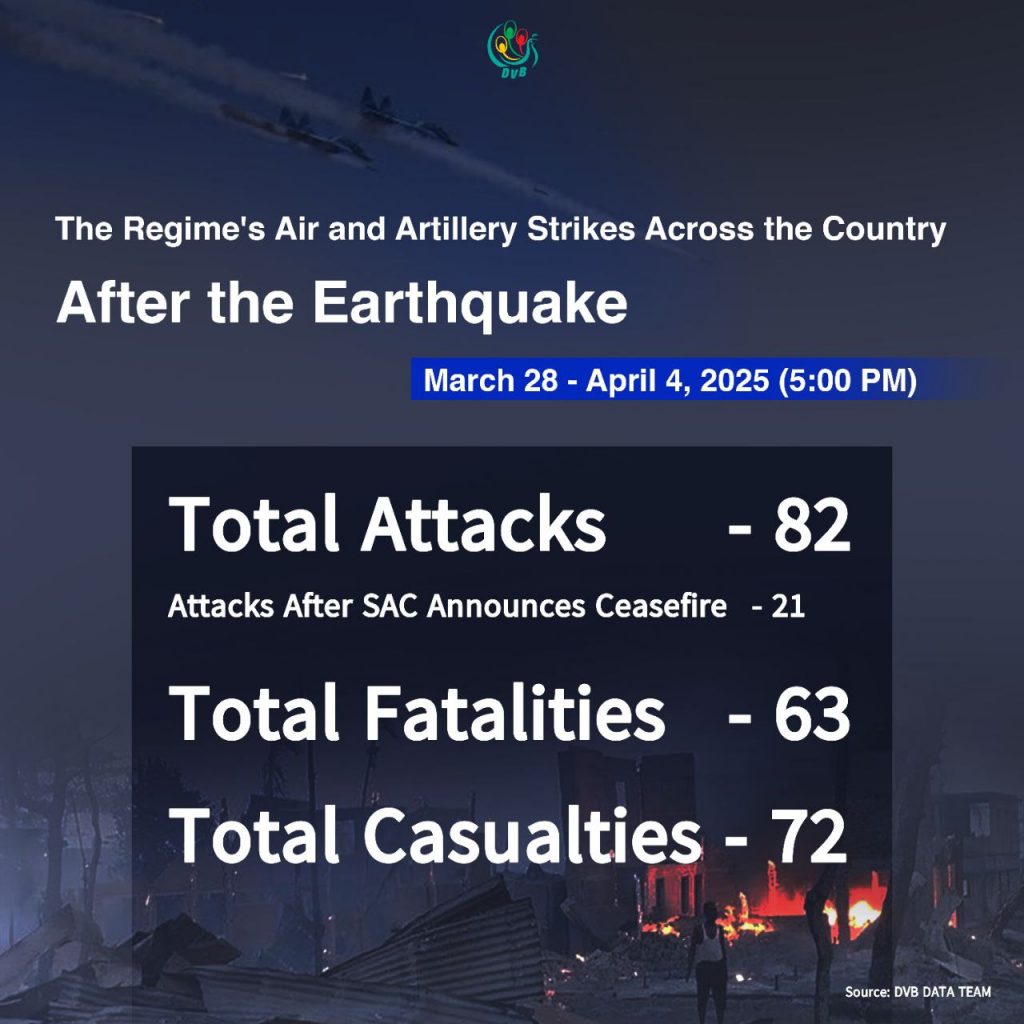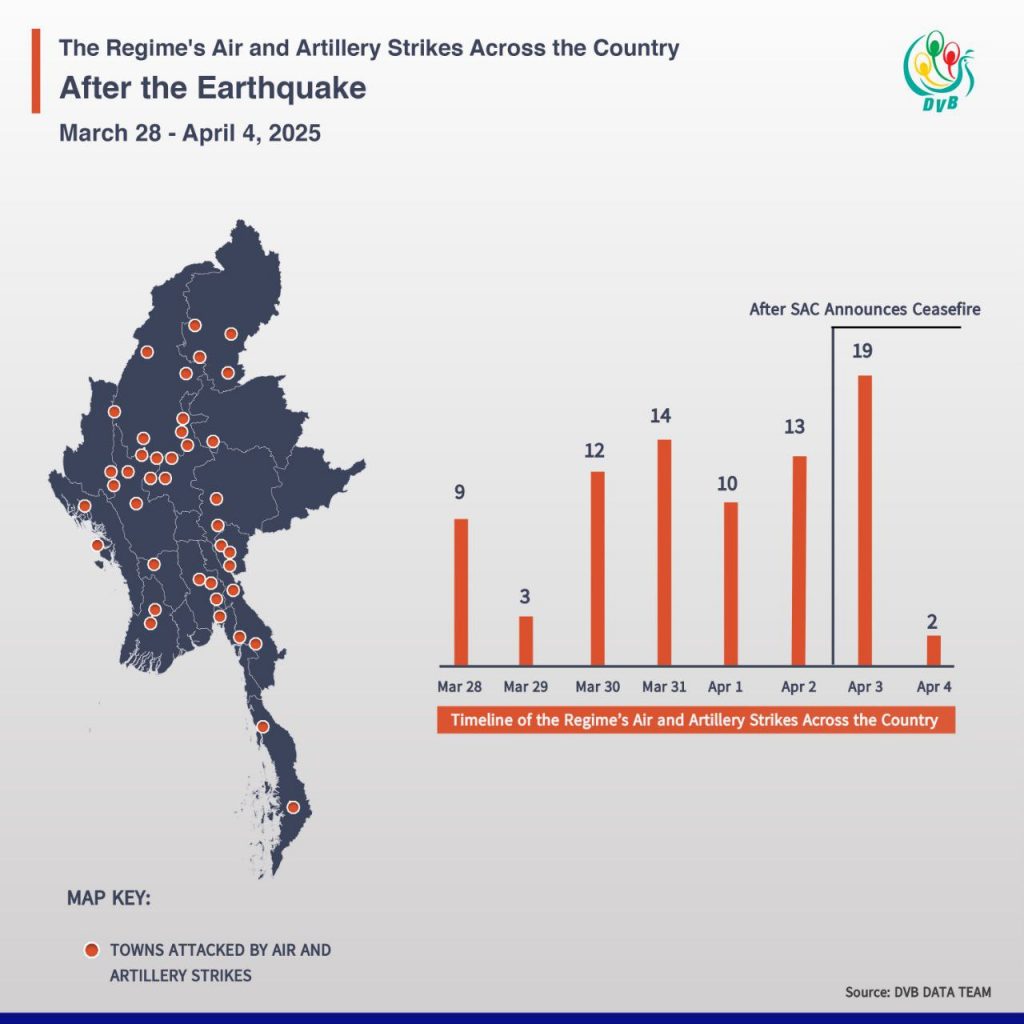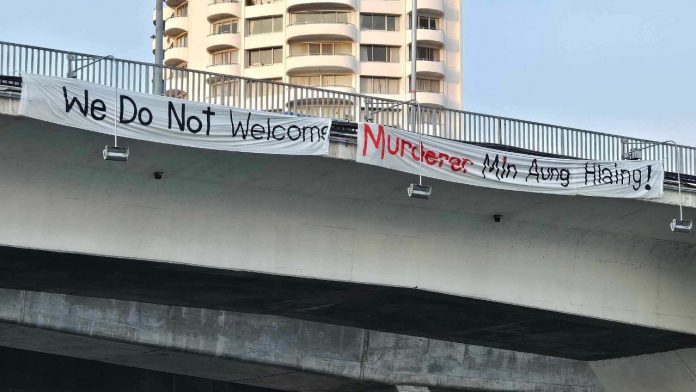A lone Thai protester held up a sign and denounced Min Aung Hlaing in the lobby of Bangkok’s Shangri-la Hotel next to the signboard welcoming delegates to the 6th Bay of Bengal Initiative for Multi-Sectoral Technical and Economic Cooperation (BIMSTEC) regional summit on Friday.
Security guards rush to him and attempt to stop the person recording the video. “Thailand does not welcome dictator murderer Min Aung Hlaing. This meeting is stained with the blood of more than 6,000 innocent people. Prime Minister Paetongtarn [Shinawatra], how do you feel about shaking hands stained with innocent people’s blood?” the lone protester shouted as he was escorted out of the building.
An image shared earlier in the day by Thai media showed Min Aung Hlaing shaking hands with Thailand’s Prime Minister Paetontarn Shinawatra. The two reportedly discussed transnational crime along the Thai-Myanmar border, drug smuggling, illegal trafficking, air pollution, and disaster prevention measures.
This was Min Aung Hlaing’s first visit to Thailand since he ousted the democratically elected National League for Democracy (NLD) government in a military coup on Feb. 1, 2021, jailing it’s leaders State Counsellor Aung San Suu Kyi, President Win Myint, and over 28,000 political prisoners.
Min Aung Hlaing installed himself Myanmar’s new ruler as head of a military regime, which seized power immediately after the coup and has violently suppressed dissent over the last four years, facing international condemnation and widespread sanctions.
The civilian-led alternative to military rule, the National Unity Government (NUG), released a statement on Thursday upon Min Aung Hlaing’s arrival to Bangkok for BIMSTEC. “His participation undermines the principles of justice and human dignity, given the immense suffering he has inflicted on the people of Myanmar.”
Earlier on Friday, a banner was hung on a bridge over Bangkok’s Chao Phraya River next to the Shangri-la Hotel. “We don’t welcome murderer Min Aung Hlaing.” The U.N. has documented over 6,000 civilians killed by pro-regime forces in Myanmar since the 2021 coup. Thai authorities quickly removed the banner.
Min Aung Hlaing left his country on Thursday, a mere six days after a devastating 7.7-magnitude earthquake struck Myanmar on March 28. A state of emergency was declared shortly afterward in the six hardest-hit regions, including Sagaing – the epicenter of the earthquake – Mandalay, Magway, Bago, Naypyidaw and Shan State.
In a rare move among Myanmar’s previous military regimes, Min Aung Hlaing requested international help in dealing with the response to the earthquake. But now he stands accused of blocking relief efforts from reaching people who are most in need.
“Sources from the ground describe a catastrophic humanitarian situation in earthquake-hit areas, especially those outside the military’s control, an absence of relief efforts, and a lack of clean water, food, and medicines,” said Volker Türk, the U.N. High Commissioner for Human Rights.
At the BIMSTEC summit in Bangkok on April 4, Min Aung Hlaing also met with Indian Prime Minister Narendra Modi and Nepal’s Prime Minister KP Sharma Oli. He expressed gratitude for the rapid assistance provided by regional countries in response to the earthquake.
“You cannot ask for aid with one hand and bomb with the other. Carrying out air strikes and attacking civilians in the same region where the earthquake struck is inhumane,” said Joe Freeman, a Myanmar researcher at Amnesty International, in a statement on April 1.
The regime in Naypyidaw is accused of scaling up attacks on anti-regime forces across the country instead of putting all of its efforts into earthquake relief and recovery since March 28.
Two days after the quake struck, the NUG announced a two-week humanitarian pause in operations by the People’s Defense Force (PDF) on March 30. The NUG administers six towns in Sagaing, Mandalay, and Magway – three of the six hardest-hit regions.
An alliance of ethnic armed groups which has seized large swathes of territory from the regime in northern Shan and Rakhine states, known as the Brotherhood Alliance, announced a one-month ceasefire, from April 1-30, to allow earthquake relief to be delivered by Beijing, via the China-Myanmar border, through northern Shan State into central Myanmar.
At first, Naypyidaw ignored international calls to halt its offensive against anti-regime groups across the country, but relented and announced a 20-day ceasefire on Wednesday, in effect from April 2-22.
The Kachin Independence Organization (KIO) announced a pause to its offensive in Kachin State to mirror the 20-day ceasefire announced by the regime.
The KIO armed wing, the Kachin Independence Army (KIA), confirmed to DVB on Friday that airstrikes and artillery attacks were carried out by regime forces in southern Kachin’s Bhamo and Waingmaw townships following the ceasefire announcement. No casualties were reported.
“The [regime] frontline military columns did not comply and continued to initiate these battles. This constitutes a violation of regulations,” Naw Bu, the KIA spokesperson, told DVB.
Residents of Kale Township in Sagaing Region told DVB that regime forces carried out arson and artillery attacks April 2-3. No casualties were reported. Residents of Tanintharyi Township in Myanmar’s southernmost Tanintharyi Region told DVB that one person was injured during a regime drone strike on Wednesday.
The Karen National Union (KNU) in Hpapun Township of Karen State and the Chinland Defense Force (CDF) in Kanpetlet Township of Chinland told DVB that airstrikes were carried out by the Myanmar Air Force on April 1-2. Two children were killed and three others injured in Karen State’s Hpapun, according to KNU Brigade 5. No casualties were reported in southern Chinland’s Kanpetlet.
DVB data stated that Myanmar regime forces conducted 82 air and artillery attacks from March 28 to April 4 with at least 21 of these attacks occurring after the ceasefire was announced on April 2. The attacks have killed at least 63 and have injured 72.
DVB data states that the death toll due to the earthquake stands at 4,159 with 2,504 bodies recovered in Mandalay—over 64 percent of the national total killed. At least 6,168 were injured, 498 were rescued, and 769 are still missing. The regime’s updated total is 3,085 killed, 4,715 injured, and 341 still missing, as of Thursday.





